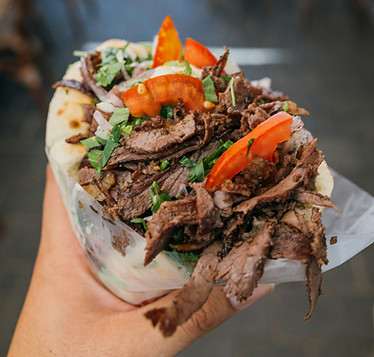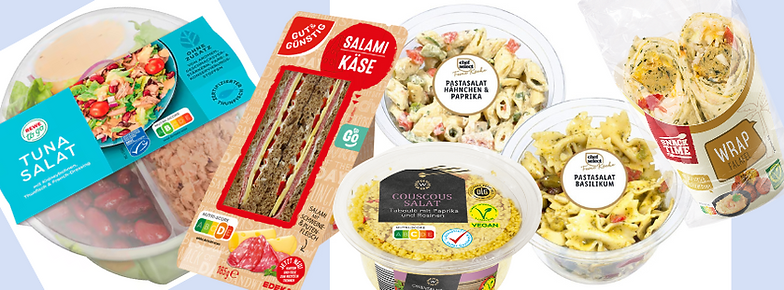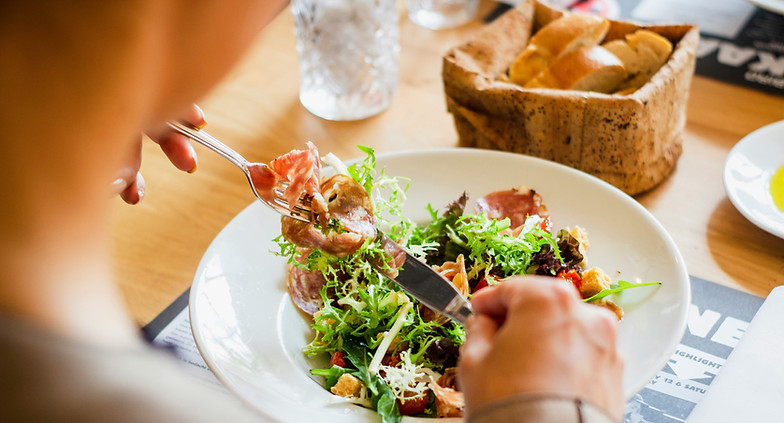Eating on the Cheap
Eating cheaply in Germany is easy to do as long as you know where to look and you plan accordingly.
Bakeries
Bakeries in Germany are a great and affordable option for lunch, offering a wide range of freshly made, ready-to-eat items that are quick, convenient, and perfect for a budget-friendly midday meal. You’ll find a mix of large bakery chains and smaller, independent bakeries located everywhere—from street corners to grocery stores to U-Bahn stations—making it easy to grab something on the go. One popular item is the belegtes Brötchen, a German bread roll typically sliced and filled with cheese, cold cuts, egg, or vegetables, usually costing between €2.50 and €4.50, depending on the filling. Bakeries can vary in quality and price—some are very affordable, while others are more upscale—so it’s worth exploring a few. In addition to belegte Brötchen, you might find Wurst im Blätterteig (sausage wrapped in puff pastry) for around €2.50 to €3.50, a Brezel (pretzel) with butter or cheese for about €1.50 to €2.50, or sweet pastries like Apfeltasche (apple turnover) or Streuselkuchen (crumb cake) for €1.50 to €3.

Belegte Brötchen
A belegtes Brötchen is a German bread roll typically sliced and filled with cheese, cold cuts, or other toppings like egg or vegetables. It's a popular and affordable snack found at bakeries and train stations, usually costing between €2.50 and €4.50, depending on the filling. Like restaurants, bakeries can have a wide range of quality and price.Some are very affordable while others are much higher in price.

Other Bakery Options
German bakeries offer a variety of affordable lunch options beyond belegte Brötchen. You might find Wurst im Blätterteig (sausage wrapped in puff pastry) for around €2.50 to €3.50, or a Brezel (pretzel) with butter or cheese for about €1.50 to €2.50. Sweet pastries like Apfeltasche (apple turnover) or Streuselkuchen (crumb cake) make a light lunch or dessert, usually priced between €1.50 and €3. These items are quick, satisfying, and budget-friendly.
Imbiss
Imbisse (snack stands) are a staple of German street food culture, offering quick, affordable, and satisfying meals for people on the go. Found in city centers, near train stations, parks, and markets, Imbisse serve as a convenient lunch or snack option and are often much cheaper than sit-down restaurants. They range from traditional German offerings to international favorites, giving you a wide variety of choices depending on what you're craving.

Döner Kebab Imbiss
One of the most popular Imbiss types in Germany is the Döner Imbiss. Brought to Germany by Turkish immigrants, döner kebab has become a beloved street food. It typically includes seasoned meat (often lamb, chicken, or beef) shaved from a vertical rotisserie and served in warm flatbread with lettuce, onions, tomato, cabbage, and sauces like garlic or spicy chili. Döner is filling, flavorful, and usually costs between €6.50 and €8. Many döner shops also offer dürüm (a wrap version), falafel, halloumi, and other vegetarian options.


Asian Imbiss
Another common type is the Asian Imbiss, which serves a range of quick and affordable dishes inspired by Chinese, Thai, or Vietnamese cuisine. You might find noodle boxes, rice dishes with sweet and sour chicken, spring rolls, or even sushi sets. Prices typically range from €5 to €12, depending on what you order.

Pizza Imbiss
You’ll also find Pizza Imbisse, where you can grab a hot slice of pizza straight from the oven for around €2 to €3. These stands often serve other Italian-style snacks like calzones, pasta boxes, or panini. While they may not compete with a full pizzeria in quality, they're perfect for a quick, satisfying bite.

Currywurst Imbiss
Another classic option is the Currywurst Imbiss, a true German street food favorite. Currywurst consists of a sliced bratwurst sausage covered in a tangy ketchup-based curry sauce, often served with a side of Pommes (fries) and a small wooden fork. It's a simple but beloved dish, especially in cities like Berlin where it has cult status. A portion of currywurst typically costs between around €3 or €5 with pommes (fries), making it an inexpensive and iconic way to experience local flavour. Many stands offer variations, including different sausage types, spice levels, or even vegetarian versions.
Grocery Store Lunch
Most grocery stores in Germany, including Aldi, Lidl, Rewe, and Edeka, have a ready-made or "to-go" section. This is normally found in the refrigerated section or near the entrance of the shop. At German grocery stores, you can often find boxed salads with ingredients like pasta, couscous, or mixed greens, usually topped with cheese, chicken, ham, or tuna, and a small packet of dressing included. Boxed sandwiches typically come on multigrain or white bread and might include fillings like ham and cheese, egg salad, or mozzarella and tomato. At between €2 and €4, the grocery store is a perfect place to pick up a quick and inexpensive meal.
.png)
Mittagsmenüs
In Germany, lunch is traditionally the biggest meal of the day, so taking advantage of a Mittagsmenü (business lunch) is not only affordable—usually around €7 to €10—but also a great way to eat like a local. These set lunch menus are often offered at sit-down restaurants, especially those serving German, Italian, Indian, or Asian cuisine, though not all places offer them, so keep an eye out for signs or chalkboards outside. It's worth noting that bakeries typically close by early evening, so if you’re hoping for a belegtes Brötchen or pastry later on for an evening snack, you’ll need to buy it earlier in the day.

Make Your Own Dinner in Jena
While we're in Jena, our hostel has a fully equipped kitchen with pots, pans, a fridge, stove, and oven, making it easy to cook meals together. Buying groceries and cooking will likely be much cheaper than eating out every night—and sharing the cost and cooking as a group can also be a fun way to bond. Just remember to clean up after yourselves, as it's a shared space and we're lucky to have access to it!

Final Pro Tips for Eating Smart in Germany
-
Plan ahead: Instead of going out to a nice restaurant every night, consider choosing one or two special dinners during the week and opting for cheaper meals on the other nights. This helps balance your budget while still enjoying a few memorable dining experiences.
-
Avoid tourist traps: Restaurants in the center of town or near major attractions often charge much higher prices than those frequented by locals. If possible, walk a few blocks away from tourist-heavy areas to find more affordable and authentic options.
-
Don’t settle for the first place you see: If you have time, take a moment to compare menus and prices. The first restaurant you come across may not offer the best value, and a short walk could lead you to a better meal at a lower cost.
-
Watch out for small daily expenses: Snacks, coffees, and casual café visits can add up quickly. For example, a daily croissant (€1.80) and coffee (€4.40) will cost you over €6 a day—that’s more than €40 over the course of a week.
-
Buy water and drinks at supermarkets: Drinks at restaurants—especially water and soda—can be surprisingly expensive. Buying beverages at a supermarket can save you several euros each day. While you usually can’t bring outside drinks into a restaurant, you can hydrate beforehand or plan for takeout to keep costs down.
